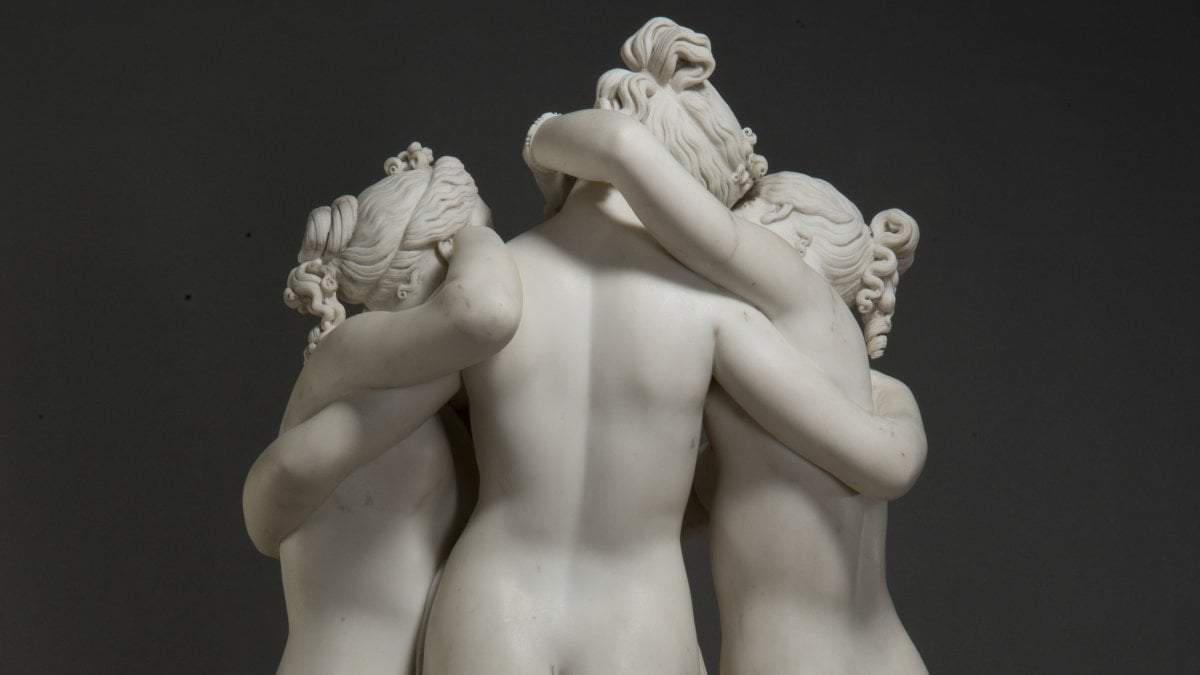Antonio Canova in relation to ancient art, a major exhibition brings the Three Graces and other masterpieces to Naples
From March 29 to June 30, 2019, the National Archaeological Museum of Naples (MANN) hosts the exhibition Canova and Antiquity, all dedicated to the relationship between Antonio Canova (Possagno, 1757 - 1822) and ancient art. Considered by his contemporaries to be a new Phidias, Canova, the father of neoclassicism, held to the principle of the great theorist Johann Joachim Winckelmann that the ancients should be imitated and not copied: and Canova seemed like the artist who could bring the ancient back to life. The exhibition examines the link between Canova and antiquity with works of different types and genres: there are marble sculptures (twelve large marbles in all) but also plaster casts, paintings, drawings, and sketches for a total of more than one hundred works, and there will be no shortage of masterpieces, such as the celebrated Three Graces coming from the Hermitage in St. Petersburg (from which other marbles also arrive:Winged Cupid, Hebe, Dancer with her hands on her hips, Cupid and Psyche standing, and the head of the Genius of Death) or theApollo from the Getty Museum in Los Angeles, as well as the Penitent Magdalene from the Palazzo Bianco Museum in Genoa and the Paris from the Museo Civico di Asolo.
Canova and Antiquity is also being held in Naples because there is a solid bond between the Venetian artist and the Campania capital: in fact, Canova first arrived in Naples at the age of 23, in 1780, on a study tour that extended to nearby Paestum and Herculaneum. Of his Neapolitan sojourn, Canova kept records in a Travel Notebook, where he was able to dwell on the monuments he visited, in particular the Sansevero Chapel where he was fascinated by Giuseppe Sammartino’s Dead Christ, and also the Capodimonte Museum and the Portici Museum, where he had the opportunity to appreciate various ancient marbles and bronzes. Canova also attended the local Academy of Fine Arts, and to this day, in the Neapolitan institute’s Gipsoteca, there are some Canova plaster casts. The sculptor would return to Naples later, in 1787, where he would work on the Venus and Adonisfor Francesco Maria Berio, to be destined for the small temple that stood in the garden of the nobleman’s palace. In the Napoleonic era he would instead work on the busts of Caroline and Joachim Murat, kings of Naples during the French occupation, and later worked for Ferdinand IV of Bourbon.
The exhibition is spread over the two floors of the National Archaeological Museum of Naples, but it extends even further: in the atrium, for example, two installations dedicated to Canova have been placed, housed in two scenic architectures 6 meters in diameter. In addition, the exhibition features an audio guide with the voice of Adriano Giannini and a soundtrack by cellist Giovanni Sollima. Visiting hours: daily (except Tuesdays, closing day), 9 a.m. to 7:30 p.m. Tickets: full 15 euros, reduced for citizens between 18 and 25 years old 2 euros. Audioguides cost 6 euros and 5 euros with openMANN (duration one hour, Italian and English). The exhibition is produced with the support of Regione Campania and under the patronage of the City of Naples and Gipsoteca e Museo Antonio Canova. The catalog is published by Electa.
Pictured: Antonio Canova, The Three Graces, detail (1812-1816; marble, St. Petersburg, Hermitage)
 |
| Antonio Canova in relation to ancient art, a major exhibition brings the Three Graces and other masterpieces to Naples |
Warning: the translation into English of the original Italian article was created using automatic tools. We undertake to review all articles, but we do not guarantee the total absence of inaccuracies in the translation due to the program. You can find the original by clicking on the ITA button. If you find any mistake,please contact us.





























